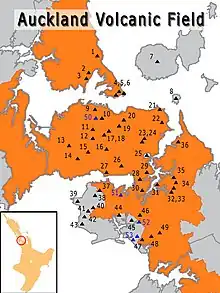| Lake Pupuke | |
|---|---|
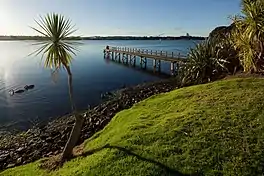 Lake Pupuke in 2010 | |
| Location | North Shore, Auckland, North Island, New Zealand |
| Coordinates | 36°46′48″S 174°45′58″E / 36.780115°S 174.766184°E |
| Lake type | Crater lake |
| Basin countries | New Zealand |
| Max. depth | 57 m (187 ft)[1] |
| Settlements | Takapuna, Milford |
Lake Pupuke (traditionally known in Māori as Pupukemoana[2]) is a heart-shaped freshwater lake occupying a volcanic crater (or maar) between the suburbs of Takapuna and Milford on the North Shore of Auckland, New Zealand. The heart shape is a result of its formation by the linking of two circular craters – a larger one forming most of the lake and a smaller one forming the arm in the northeast. Separated from the sea by less than 200 m at one point, it has a circumference of about 4.5 km and reaches 57 m[1] in depth. It is popular for recreational activities and the lakefront property around it.
Geology
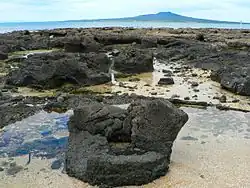
Lake Pupuke is one of the oldest known features of the Auckland volcanic field, erupting an estimated 193,200 years ago.[3][4]
Other similar craters in the Auckland volcanic field were either buried by later eruptions, or breached by erosion as rainwater collected and overflowed the edge of the crater. Lake Pupuke remains a lake because, unlike the other vents, its eruptions produced substantial lava flows; water can thus escape through cracks in the lava reaching under the crater wall, creating a series of freshwater springs along the beaches between Takapuna and Milford. The lava flow at the end of Takapuna Beach enveloped a kauri forest, producing an internationally significant collection of tree moulds, which has been called "New Zealand’s only example of a fossil forest preserved in a lava flow" and which "ranks among the best examples in the world."[5] Some moulds have escaped burial by the boat ramp and car park built on top of the lava, and can be viewed at low tide.[6]
A small scoria cone existed to the west of Lake Pupuke, which was quarried during European settlement.[7]
History
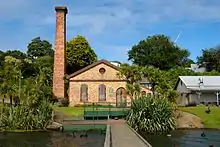
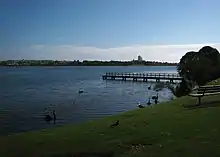
In 1894, a pump house was built on the shore of the lake to supply fresh water to the local area. This was replaced in 1906 by a second pump house. As a result of increasing demand, the water level of the lake fell and water quality decreased. The use of the lake as a fresh water supply was discontinued in 1944 when new supplies were sourced from reservoirs in the Waitākere Ranges. The second pump house has become a Category II protected building under the New Zealand Historic Places Trust in 1983. The building is now home to The PumpHouse Theatre with three performance spaces including an outdoor amphitheatre.[8][9]
Vallisneria plants were introduced to the lake, and dominates much of the lake floor.[7]
Māori mythology
A Māori myth surrounding the lake tells of a tupua couple, children of the fire gods. After quarreling and cursing Mahuika, the fire-goddess, their home on the mainland was destroyed by Matahoe, god of earthquakes and eruptions, on Mahuika's behalf. Lake Pupuke resulted from the destruction, while Rangitoto Island rose from the sea as their exile. The mists surrounding Rangitoto at certain times are considered the tears of the tupua couple for their former home.[10]
Human use
Close to the Takapuna city centre, the lake is popular not only with wild birds (such as shags) but with picnickers, paddlers, kayakers,[11] rowers,[12] yachtsmen, divers, and windsurfers (lessons have been given on the lake).[13] Free divers (no tanks) have practiced in the lake.[14] College rowing crews use it.[15] There have been boating races.[16] and the Pupuke Boating Club operates there.[16] Takapuna Boating Club hosts regattas.[17]
The Auckland Dragon Boat Association runs an annual regionals race event on the lake, with 200m, 500m and 2 km races.[18] The lake is the venue for Dragon Boat, Canoe sprints, Canoe marathon, and Waka Ama sprint racing within the Canoe Competition at the World Masters Games 2017 held in Auckland.[19]
Lake Pupuke is suitable for swimming but is murky and contains thick vegetation, and there have been drownings.[12] The lake has been tested for bacteria and generally meets safe swimming conditions.[20]
In 2007, recreational fishing has become more prominent since rainbow trout[21] were released into the lake from a fish hatchery. However, since there are no actual streams entering or leaving the lake, trout will not be able to reproduce naturally, and new trout will have to be released periodically.[21] Other fish in the lake include tench, perch, rudd, and carp.[21]
The crater wall has been quarried in several places, most intensely on the western side between Shea Terrace and Rangitira Avenue, where Smales Quarry continues to operate. A long thin lagoon called Quarry Lake has been formed there by flooding a former quarry area.[1]
Lakeside real estate is expensive. Empty lakefront land is rare; one (almost 1,200-square meter) undeveloped parcel cost $2.7 million in 2008.[22] Lake Pupuke is identified as a "high risk" area in the event of a tsunami, and a high-tech phone alert system was developed for North Shore residents in case of an emergency.[23]
References
- 1 2 3 Lake Pupuke Inspection Report No. KC7 Archived 24 May 2010 at the Wayback Machine (from the Lake Pupuke assessment, North Shore City Council, 20 June 2006. Accessed 2008-01-12.)
- ↑ Pegman, David M (August 2007). "The Volcanoes of Auckland" (PDF). Manukau City Council. Mangere Mountain Education Centre. Archived from the original (PDF) on 24 March 2012. Retrieved 6 October 2021.
- ↑ Leonard, Graham S.; Calvert, Andrew T.; Hopkins, Jenni L.; Wilson, Colin J. N.; Smid, Elaine R.; Lindsay, Jan M.; Champion, Duane E. (1 September 2017). "High-precision 40Ar/39Ar dating of Quaternary basalts from Auckland Volcanic Field, New Zealand, with implications for eruption rates and paleomagnetic correlations". Journal of Volcanology and Geothermal Research. 343: 60–74. Bibcode:2017JVGR..343...60L. doi:10.1016/j.jvolgeores.2017.05.033. ISSN 0377-0273.
- ↑ Janssen, Peter (January 2021). Greater Auckland Walks. New Holland Publishers. p. 45-46. ISBN 978-1-86966-516-6. Wikidata Q118136068.
- ↑ Geologist Bruce Hayward in Protecting North Shore City’s fossil forest (from a North Shore City Council press release, 31 May 2006. Accessed 2008-01-05)
- ↑ "Education Kit – Volcanoes" (PDF). Auckland War Memorial Museum, Earthquake Commission. Auckland War Memorial Museum. p. 12. Archived from the original (PDF) on 26 January 2007. Retrieved 23 May 2007.
- 1 2 Cameron, Ewen; Hayward, Bruce; Murdoch, Graeme (2008). A Field Guide to Auckland: Exploring the Region's Natural and Historical Heritage (rev. ed.). Random House New Zealand. p. 145. ISBN 978-1-86962-1513.
- ↑ History of The PumpHouse Archived 17 May 2006 at archive.today (from the official website)
- ↑ Dionne Christian (23 September 2005). "An Auckland setting for an English story". The New Zealand Herald. Retrieved 13 September 2009.
- ↑ Rangitoto Archived 13 July 2006 at the Wayback Machine (from the Auckland Regional Council website)
- ↑ Estelle Sarney (31 March 2007). "Milford – Lake placid". The New Zealand Herald. Retrieved 13 September 2009.
- 1 2 "Drowned man's body found in lake, mother in hospital". The New Zealand Herald. 2 January 2008. Retrieved 13 September 2009.
- ↑ "Windsurfin' safari gives young their water wings". The New Zealand Herald. 13 January 2006. Retrieved 13 September 2009.
- ↑ Peter Jessup (17 December 2004). "Free diving: Breath taking". The New Zealand Herald. Retrieved 13 September 2009.
- ↑ JENNI RUTHERFORD (6 March 2002). "College Sport: Crews poised to raise splash on Lake Karapiro". The New Zealand Herald. Retrieved 13 September 2009.
- 1 2 "Sails from a bygone era". The New Zealand Herald. 27 January 2001. Retrieved 13 September 2009.
- ↑ "Takapuna – an exclusive extract". The New Zealand Herald. 9 September 2006. Retrieved 13 September 2009.
- ↑ "Auckland Dragon Boat Association". Auckland Dragon Boat Association. Retrieved 7 March 2017.
- ↑ "Dragon Boating". WMG2017. Retrieved 7 March 2017.
- ↑ Gibson, Eloise (2 July 2009). "Popular swim spots spoiled by bacteria". The New Zealand Herald. Retrieved 13 September 2009.
- 1 2 3 Thompson, Wayne (7 May 2007). "Lake's new attraction – gold at the end of the rainbow". The New Zealand Herald. Retrieved 13 September 2009.
- ↑ Michelle Coursey (2 March 2008). "The most expensive handful of dirt in NZ?". The New Zealand Herald. Retrieved 13 September 2009.
- ↑ Martha McKenzie-Minifie (24 May 2007). "Tsunami phone alert system on way". The New Zealand Herald. Retrieved 13 September 2009.
External links
- "Former Pumphouse". New Zealand Heritage List/Rārangi Kōrero. Heritage New Zealand.
- The PumpHouse (from the official theatre and art gallery website)
- Contour map of lake catchment (from the North Shore City Council website)
- Photographs of Lake Pupuke held in Auckland Libraries' heritage collections.
